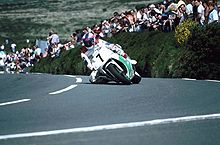Snaefell Mountain Course
The first TT race over the Snaefell Mountain Course or Mountain Course was the 1911 Isle of Man TT Races. This was followed in 1923 with the introduction of the Manx Amateur Motorcycle Road Races – a race originally reserved for amateurs and raced on the same Mountain Course. In 1930 it changed its name to the Manx Grand Prix. For the 1911 event two separate races were introduced. A four lap Junior TT Race for 300 cc single-cylinder and 340 cc twin-cylinder motorcycles and was the first event on the new course and was contested by 35 entrants. It was won by Percy J. Evans riding a Humber motorcycle in 3 hours, 37 minutes and 7 seconds at an average speed of 41.45 mph. The Senior TT Race was open for 500 cc single-cylinder and 585 cc twin-cylinder motorcycles and was contested over 5 laps of the new 37.5 mile Snaefell Mountain Course. The new technical challenges of the Mountain Course forced changes on entrants and motorcycle manufacturers alike. The American Indian Motor-Cycle factory fitted a two-speed gearbox and chain-drive. This proved to be the winning combination when Oliver Godfrey won the 1911 Isle of Man Senior TT race riding an Indian in 3 hours, 56 minutes and 10 seconds at an average speed of 47.63 mph. In contrast the Matchless motorcycles were fitted with a six-speed belt drive and Charlie Collier riding a Matchless motorcycle finished second in the 1911 Senior TT race but was later disqualified for illegal refuelling. During practice for the 1911 race Victor Surridge died after crashing his Rudge motorcycle at Glen Helen. For the 1912 event the single and twin-cylinder classes were combined with a 350 cc capacity limit for the Junior TT and a 500 cc capacity for motorcycles for the Senior TT race. In 1913 Major Tommy Loughborough replaced Freddie Straight as secretary of the Auto-Cycle Club and promptly decided to make the races more difficult. The Junior and Senior races w

re to be run in sections. The Junior TT race was divided into two races of two and four laps and the Senior TT race consisted of a three lap race followed by a four lap race combined with the Junior TT event. In 1914 the Junior TT was reduced to 5 laps and the start-line moved to the top of Bray Hill to increase paddock space of the competitors. The use of crash-helmets was made compulsory. The 1914 Junior TT was held in heavy rain and mist on the Mountain Section of the course and was won by Eric Williams riding an AJS motorcycle in 4 hours, 6 minutes and 50 seconds at an average speed of 45.58 mph.[17] The race was marred by the death of Frank Walker riding a Royal Enfield motorcycle who had been leading until a puncture on the third-lap. In the following pursuit of the leaders he fell twice and on the last-lap over-shot the finish line in Ballanard Road and crashed into a wooden barrier placed across the road and posthumously declared a third place finisher by the ACU race committee. Snaefell Mountain Course or Mountain Course[1] is a road-racing street circuit used for the Isle of Man TT and Manx Grand Prix Races held in the Isle of Man from 1911 and 1923 respectively. The racing is held on public roads closed for racing by an Act of Tynwald (the parliament of the Isle of Man). It is the oldest motor-cycle racing circuit still in use. The course is 37.733 miles (60.73 km)[2] in length and the start-line is situated on the A2 Glencrutchery Road in the town of Douglas. The racing circuit is based on a number of public roads on the Isle of Man including the primary A2 Douglas to Ramsey road, A1 Douglas to Peel road, A3 Castletown to Ramsey Road and the primary A18 Snaefell Mountain Road. The highest point of the course is situated on the primary A18 Mountain Road between the Bungalow and Hailwood's Height at spot height 422 metres (1,385 ft) above sea level ( 54°14?47.47?N 4°27?57.18?W).